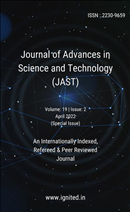Welding of Different Metals Across Ferritic Substrates: A Thermal Modeling
DOI:
https://doi.org/10.29070/zfya1g64Keywords:
Ferritic steels , Dissimilar metal welds (DMWs), Carbon migration , SimulationAbstract
In the modern era, scientists are able to accurately predict the microstructural evolution ofcomplex metallurgical systems, including the formation of phases at elevated temperatures over l.ongperiods of time. Those calculations are useful because they provide insight without the need forlaborious and costly experiments. Computational simulations are especially useful in the powergeneration industry, where the service parameters have a significant impact on the materials used.Dissimilar metal welds (DMWs) ranging in hardness from T23 to T91 will be the focus of thisinvestigation into the application of thermodynamic simulations to their behaviour under hightemperature,creep-like conditions. Precipitation sequences in the base metals, as well as carbonmigration in DMWs from the higher alloyed to the lower alloyed material at elevated temperatures, andthe distribution of precipitates across the fusion line of the DMWs, are all calculated using the softwareMatCalc. The simulation results are validated by testing creep-exposed cross-weld samples at 80 MPa,600 °C, and 625 °C for up to 14,000 hours.Downloads
References
Vaillant JC, Vandenberghe B, Hahn B, Heuser H, Jochum C (2008) T/P23, 24, 911 and 92: new grades for advanced coal-fired power plants – properties and experience. Int J Press Vessel Pip 85:38–46. https://doi.org/10.1016/j.ijpvp.2007.06.011
Anand R, Sudha C, Saroja S, Vijayalakshmi M (2013) Experimental and thermokinetic simulation studies on the forma- tion of deleterious zones in dissimilar ferritic steel weldments. Metall Mater Trans A 44A:2156–2170. https://doi.org/10.1007/ s11661-012-1591-9
Dawson KE (2012) Dissimilar metal welds. Dissertation, University of Liverpool
Sudha C, Terrance ALE, Albert SK, Vijayalakshmi M (2002) Systematic study of formation of soft and hard zones in the dissim- ilar weldments of CrMo steels. J Nucl Mater 302:193–205. https:// doi.org/10.1016/S0022-3115(02)00777-8
Sudha C, Thomas Paul V, Terrance ALE, Saroja S, Vijayalakshmi M (2006) Microstructure and microchemistry of hard zone in dis- similar weldments of Cr-Mo steels. Weld J:71–80
Thomas A, Pathiraj B, Veron P (2007) Feature tests on welded components at higher temperatures – material performance and residual stress evaluation. Eng Fract Mech 74:969–979. https:// doi.org/10.1016/j.engfracmech.2006.08.017
Wang Y, Li L (2016) Microstructure evolution of fine-grained heat affected zone in type IV failure of P91 welds. Weld J 95:27–36
E. Kozeschnik: MatCalc (Materials Calculator); software available at https://www.matcalc-engineering.com/index.php. Accessed 20 Oct 2019
Darken LS (1949) Diffusion of carbon in austenite with a disconti- nuity in composition. Trans AIME 180:430–438
Dittrich F, Mayr P, Martin D, Siefert JA (2018) Characterization of an ex-service P22 to F91 ferritic dissimilar metal weld. Weld World 62:793–800. https://doi.org/10.1007/s40194-018-0569-7.
Strilkova L, Kubon Z, Vodarek V (2010) Creep failure characteris- tics in P23/P91 dissimilar welds. Conference Paper - METAL 2010.
Amsupan S, Consonni M, Poopat B, Sirivedin K (2015) Influence of the welding heat cycle on the HAZ properties of T23 joints. Int J Inst Mater Malays 2-1:233–24
Dawson K, Tatlock G (2011) The stability of fine, sub-grain micro- structures within carbon depleted regions of dissimilar metal, ferrit- ic, creep resistant welds. ASME 2011 pressure vessels and piping conference. https://doi.org/10.1115/PVP2011-57868
Laha K (2014) Integrity assessment of similar and dissimilar fusion welded joints of Cr-Mo-W ferritic steels under creep condition. Proc Eng 86:195–202. https://doi.org/10.1016/j.proeng.2014.11. 028.
Foret R, Zlamal B, Sopousek J (2006) Structural stability of dissim- ilar weld between two CrMoV steels. Weld J:211–217.
Vodarek V, Kubon Z, Foret R, Hainsworth SV (2008) Microstructural evolution in P23/P91 heterogeneous welds during creep at 500-600°C. Safety and reliability of welded components in energy and processing industry proceedings of the IIW internation- al conference, pp 233–238.
Case 2199: 9Cr-1Mo-1W-Cb Material, Cases of American Society of Mechanical Engineers Pressure Vessel, Code Case 2199–6, 2011 DIN EN 10302:2008–06 – Creep resisting steels, nickel and cobalt alloys






